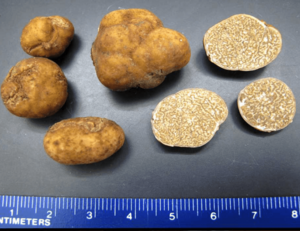Pecan truffle facts for kids
Quick facts for kids Pecan truffle |
|
|---|---|
 |
|
| Fruiting body of Tuber lyonii | |
| Scientific classification | |
| Genus: |
Tuber
|
| Species: |
lyonii
|
| Synonyms | |
|
|
| Tuber lyonii | |
|---|---|
| Mycological characteristics | |
| glebal hymenium | |
| hymenium attachment is not applicable | |
| lacks a stipe | |
| ecology is mycorrhizal | |
| edibility: choice | |
Tuber lyonii, also known as the American brown truffle or the pecan truffle, is a special type of truffle that grows in North America. It gets its name "pecan truffle" because it's often found near pecan trees. These truffles grow underground, usually close to the roots of trees.
For a long time, pecan farmers thought these truffles were just a bother. But now, they are becoming very popular as an edible mushroom. People enjoy eating them, and they can be quite valuable, sometimes selling for over $160 per pound!
Contents
What Does the Pecan Truffle Look Like?
The pecan truffle has an outer skin, called a peridium, that is light brown. It can be round, or it might have bumpy parts that look like "lobes." Its surface can be smooth or have grooves.
If you cut a mature truffle in half, you'll see a cool marbled pattern inside. It has white parts that don't produce spores, mixed with brown parts where the spores are made. These truffles usually sit just a few inches under the ground. Sometimes, they even poke up through the soil. If they do, they might get dried out or bothered by insects.
Where Do Pecan Truffles Grow?
Pecan truffles are found across a wide area in North America. They grow from the northern parts of Mexico all the way up to Québec, Canada. You can also find them from the eastern coast of the United States to the southern Rocky Mountains.
Trees That Are Friends with Truffles
These truffles often grow with certain types of trees. They are most commonly found near Carya trees, which include hickories and pecans. They also love to grow with Quercus trees, like oaks. Oaks are actually the best tree friends for many types of truffles.
Sometimes, pecan truffles are also found with Corylus (hazelnut) trees and Castanea (chestnut) trees. They have even been found growing near Basswood trees!
Favorite Growing Spots
One of the best places to find T. lyonii is in well-cared-for pecan orchards. They especially like the edges of areas where farmers use weed killers. This might be because the soil in these spots has a higher pH level, which means it's less acidic. Pecan trees usually grow best in soil with a pH of about 7 or 7.5.
When Do Truffles Grow?
Pecan truffles seem to grow best on younger trees. They usually produce their fruiting bodies (the part we eat) in late summer and into the fall. The exact time depends on the weather in that area. In warmer places, like Florida and southern Georgia, they can keep growing through the winter, sometimes even until February.
The truffles can grow quite large, up to 12 centimeters (about 5 inches) across when they are fully grown. However, most of them are smaller, usually between 0.5 and 2 centimeters (about 0.2 to 0.8 inches).

